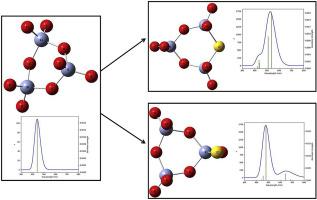Journal of Molecular Graphics and Modelling ( IF 2.7 ) Pub Date : 2020-05-05 , DOI: 10.1016/j.jmgm.2020.107617 Shivangi Garg 1 , Navjot Kaur 1 , Neetu Goel 1

|
Different isomers of (CrO3)n (n = 1–10) cluster units have been investigated using Density functional approach. Their stability and reactivity has been analyzed by plotting chemical potential and HOMO-LUMO gap as a function of cluster size. The CrO3, (CrO3)6 and (CrO3)9 are identified as the most reactive species. Reactivity of each atomic site in the cluster has been interpreted using local reactivity descriptors called Fukui Function plots. The clusters have been doped with sulfur by adding it as substitutional impurity, effect of sulfur doping has been understood by analyzing excitation energies and absorption wavelengths using time dependent-DFT(TDDFT) at CAM-B3LYP level of theory.
中文翻译:

DFT和TDDFT概念性研究纯和硫掺杂(CrO3)n(n = 1-10)团簇的电子结构和反应性。
(CrO 3)n(n = 1-10)簇单元的不同异构体已使用密度泛函方法进行了研究。通过绘制化学势和HOMO-LUMO缺口随团簇大小的关系图,分析了它们的稳定性和反应性。CrO 3,(CrO 3)6和(CrO 3)9被确定为最具反应性的物种。簇中每个原子位点的反应性已使用称为Fukui函数图的局部反应性描述符进行了解释。团簇已经通过添加硫作为替代杂质而被掺杂,通过在CAM-B3LYP的理论水平上使用时间依赖性DFT(TDDFT)分析激发能和吸收波长,可以理解硫的掺杂作用。











































 京公网安备 11010802027423号
京公网安备 11010802027423号